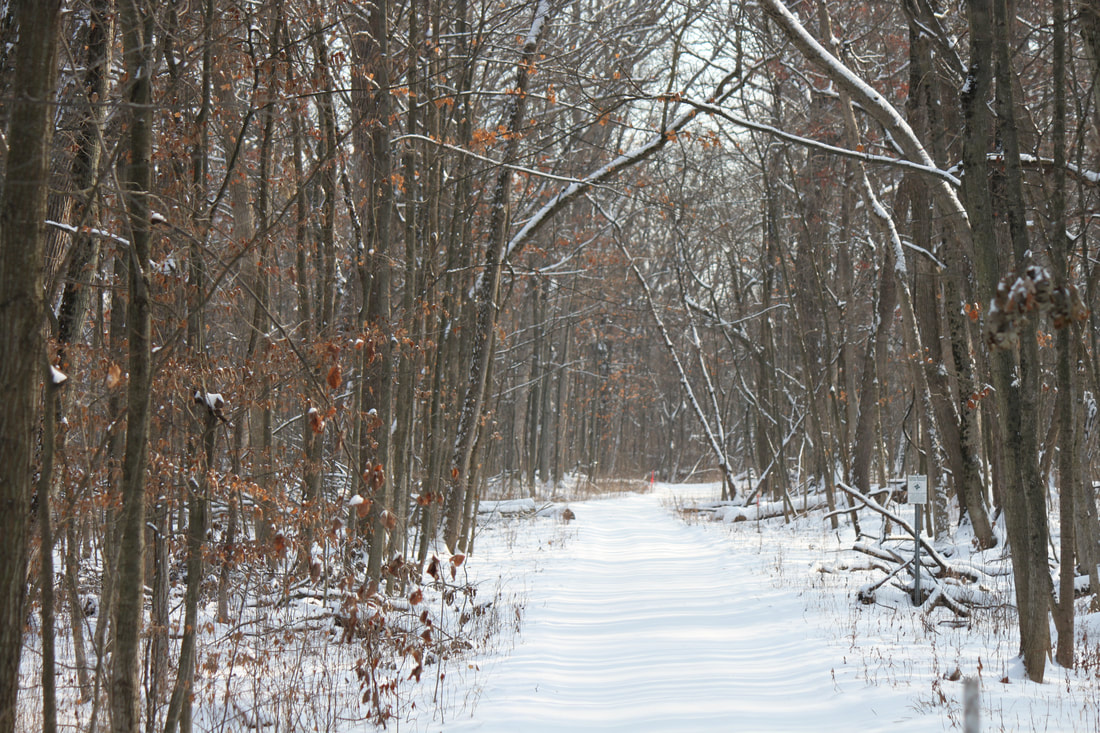|
by Luke Buckardt
This winter has been brutally cold. With an average temperature of 19.4 degrees F, it is the fourth coldest on the record books here in the Chicago area. Schools have been cancelled and people have been warned to stay inside on days with negative wind chills. But what happens to the rest of the wintery world when temperatures dip to such lows? The plants and animals in Ryerson also have to cope with these temperatures, but have no relief. Both the plants and animals use incredible adaptations in order to make it through the long winter. Many of the trees in Ryerson are deciduous, which literally translates to “tending to fall off.” Tree species, such as the Bur oak and the Sugar maple, go through a yearly change in order to prepare for winter. When light conditions shorten in the fall, trees begin to go through abscission, or loss their leaves. This assists the tree in two major areas. Primarily, it conserves water. Leaves are where the tree transpires, or gathers CO2 for the transformation into oxygen. However, water is lost through the stoma, or pores in the underside of the leaf, during this process. In order to conserve water during the winter, deciduous trees drop these leaves. They also drop their leaves in order to conserve energy. It is not efficient for many temperate tree species to continue maintaining leaves throughout the winter, as the leaves do not receive ample sunlight. The tree would be using excess energy to keep their leaves throughout the winter, so it sheds them when light conditions begin to deteriorate. Coniferous trees handle the winter through a different method that does not involve dropping their specialized leaves, called needles. Needles differ from deciduous leaves in two major areas. First, they continually transpire throughout the year. Needles have a waxy cuticle, or outer covering, that limits the amount of water that is lost during the process. Their stoma are sunken deeper into the plant tissue, which also helps retain water. Conifers are also shaped differently in order to prevent damage from snow and ice. Pines, firs and cedars have a conic shape, with a thin top and wider base. This shape does not allow for snow to build up, which can potentially break branches, endangering the tree. Animals must also endure the cold winters in the Chicago land area, and have many specialized physiologic adaptations. One of the most prevalent animals in Lake County is the ubiquitous White-tailed deer. They have a few adaptations that allow for them to maintain internal temperatures when the thermometer dips below zero. First, they, like other mammals, abide by Bergmann’s rule. It states that as a mammalian species ranges farther north, they are larger in colder climates. By increasing size, they are better “designed” for colder temperatures. They have a greater mass to surface ratio and therefore have an easier time retaining heat. Deer also have unique fur that helps them stay warm. Their fur has multiple layers, which help trap heat against their skin. White-tailed deer have guard hairs that are exposed to the elements. The outer hairs are hollow in order to trap air, which is used to insulate the animal. When it is extremely cold, deer bed down in deep snow. Snow is about 90 percent air, and acts as a wonderful insulator. Another amazing animal is the Wood frog. Being only 2 inches long can be tricky when temperatures get below freezing, but they enlist an incredible method, which helps them endure such temperatures, they freeze. Wood frogs hibernate in the top layers of soil. During the fall, the wood frog begins to store urea within its tissue. While in hibernation, they convert glycogen into glucose. Both of these help break up internal ice formation within the blood and other fluids. They can withstand up to 65% of their tissue freezing and still survive through hibernation. Animals also enlist behavioral adaptations to combat the chilling temperatures. Birds, when it gets particularly cold, maintain their body temperature by manipulating their feathers. Birds at feeders are often seen “puffed up” during the winter months. They are actually expanding their feathers and trapping air for increased insulation. Birds also enact thermogenesis to warm themselves. Although it is not as apparent as with humans, birds shiver to maintain an appropriate body temperature for survival. Certain animals will change their social behavior to perpetuate survival as well. The Southern flying squirrel, a local Lake County resident, is primarily a loner. Throughout most of the year, they live by themselves. However, when temperatures become dangerously low, they huddle together in a collective den. The added bodies maintain a more constant temperature throughout the whole den, allowing for more individuals to survive. While we are buried under our comforters in our toasty houses, the world around us continues to endure and in many cases thrive during these frigid days. Make sure to look outside to enjoy the nature around us, and to find many more adaptations that keep the plants and animals of Lake County going on these chilly days.
0 Comments
|
AuthorThis blog is written by the staff and partners of Brushwood Center at Ryerson Woods Archives
February 2022
Categories |
|
21850 N. Riverwoods Rd.
Riverwoods, IL 60015 224.633.2424 [email protected] ABOUT BRUSHWOOD BECOME A PARTNER VOLUNTEER AND JOB OPPORTUNITIES |
Brushwood Center at Ryerson Woods is committed to enabling the participation and enjoyment of our programming and events for all visitors. At Brushwood Center, you will have open access to accessible parking and entrance to the house, a gender neutral bathroom, and changing tables.
If you require certain accommodations in order to observe or attend our events, or have questions regarding accessibility of our facilities, please contact our Director of Public Programs and Music, Parker Nelson, at [email protected] or at (224) 633-2424 ext. 1. Programming and events at Brushwood Center are available to everyone, including but not limited to age, disability, gender, marital status, national origin, race, religion, and sexual orientation. Site Photography by: In Life Photography, Michael Kardas Photography, Ewa Pasek Photography, Brushwood Staff, and Josiah Shaw Productions |
OPEN TO THE PUBLIC Monday - Thursday & Saturday: 10am - 3pm Sunday: 1pm - 3pm and by appointment |

 RSS Feed
RSS Feed
